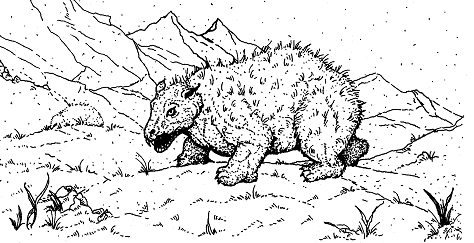TUNDRA BEAST
by Douglas Lent

FREQUENCY: Rare
NO. APPEARING: 1-2
ARMOR CLASS: 5 (back and head),
7 (underside)
MOVE: 3?
HIT DICE: 4 + 4
% IN LAIR: 90%
TREASURE TYPE: Nil
NO. OF ATTACKS: 1
DAMAGE/ATTACK: 5-30
SPECIAL ATTACKS: 4 En tangle, surprise
on 1-5
SPECIAL DEFENSES: Camouflage
MAGIC RESISTANCE: Standard
INTELLIGENCE: Semi-
ALIGNMENT: Neutral
SIZE: L (9? long, 4? tall at shoulder)
PSIONIC ABILITY: Nil
Attack/Defense Modes: Nil
LEVEL/X.P. VALUE: V / 285 + 5/hp
As their name implies, tundra beasts are
native to subarctic and northern temperate
plains. They are carnivorous,
hunting
either alone or in mated pairs. Tundra
beasts usually stay in one area, moving on
only when prey becomes scarce.
Tundra beasts are large creatures with
four short legs and big, padlike feet. Their
upper bodies are covered with long, grass-
like fur which can quickly change color to
match that of the surrounding vegetation.
Their undersides and vaguely triangular
heads are hairless and brown. The eyes of a
tundra beast are dull red, and the many
teeth in its huge jaws are a dirty yellow.
Tundra beasts are able to pull both their
head and legs beneath their bodies; when
doing so, they resemble nothing more than
low, grassy mounds, and they are able to
surprise their prey on a 1-5 on a six-sided
die. Tundra beasts can sense ground move-
ment within 15? of themselves, allowing
them to detect approaching victims while
camouflaged. They have normal utravision.
Once per day, tundra beasts are able to
cast an entangle spell. They will use this to
stop or slow their quarry once it has ap-
proached within 10? of them. Tundra beasts
are immune to the effects of their own or
another tundra beast?s entangle spell, but
not those cast by druids or other creatures
able to use that spell.